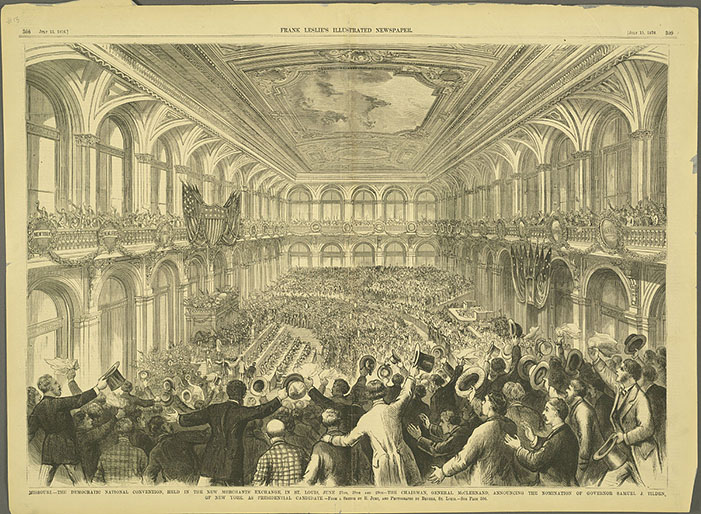
How eCommerce is Like the 2016 Presidential Election

Photo by Cornell University Library – originally posted to Flickr as Missouri – The Democratic National Convention, CC BY 2.0
Unless you have been off the grid for the last year or so, avoiding every type of media in existence (in that case, welcome back to the internet!) you’ve heard the seemingly endless news about the 2016 U.S. presidential race. Now more than ever, there is a constant stream of information including results and statistics, comments from candidates and pundits, and election-related controversy being covered by all channels of the media. While this seems to be spilling over from the realm of politics into that of entertainment, this is the process that has evolved in the age of information. It leads up to people making a choice, whether based on facts, emotion, compromise, prejudice, even misinformation—probably some combination of all of the above for most. There is of course only one President, and it is up to them to convince the voters that they are the one that can best hold the office of POTUS.
In much the same way, shoppers often compare the relative value of a certain product that meets their needs (or wants) at several online shops before deciding what to buy, and where to buy it. Each shop competes for the buyer’s vote, and seldom does one order two or more of the same product from two different stores. While the stakes are admittedly higher in picking the leader of one of the most powerful countries in the world, there are some definite parallels. Shop owners and eCommerce experts can learn a lot from the election process.
The Candidate is the Shop, as Much as the Product
While it may be somewhat satisfying to compare our current crop of candidates to cars, shoes, or brands of detergent on a supermarket shelf, within this examination of eCommerce, the closest analog to the candidate is the storefront. Ultimately your customers will take home or have delivered the product they want, whether they buy it from you or from your competitor. (Getting them to buy a different product is saved for another discussion.) The value proposition, level of trust, presentation, service and yes, the price all contribute to this decision.
The "candidates" for shoppers’ purchase dollars all make themselves known through various channels, from paid search, which is like a campaign ad, to reviews, which can be compared to word of mouth or the press, to social media presence, which is essential in both arenas. In much the same way as a grassroots campaign can be a road to the White House, it is not simply a matter of the most dollars spent on advertising creating the most sales. It requires engagement with your customers.
Stand on Your Platform
While watching the debates, both Republican and Democrat, you will see a wide variety of methods by which candidates make their points known. Take for example the platform of better education for American college students. One candidate might cite his or her record on supporting educational bills, devoting funds to improving or building schools, or reducing tuition costs for students. One might propose free education, while another might advocate a more moderate approach of reducing costs and putting limits on debt. When weighing the pros and cons of the policies of your store, you’ll have to consider what’s right for your business when making promises to your customers.
Whatever your value proposition, lay it out in clear, intelligible language and with captivating images. Curate content that highlights not only your product but your brand and the brands you carry. By giving more detail about what sets your shop apart from the competition, you make the case for their vote in your favor.
Run a Clean Campaign or Sling Some Mud?
Another campaign tactic is to attack the competitor’s failings, for example to address a poor record on education in his or her past career as a senator or governor, or to point out the candidate has no experience in this area. Online shops may not usually attack their competitors with such fervor, but each must offer a better proposition. You don’t have to badmouth anyone—it’s probably a bad idea for a number of reasons, one being that you are calling attention to a competitor. This is essentially a passive-aggressive approach. Consider that your customers have already looked at your competitor’s site, or will after they visit yours. What are their failings? Does your competitor who is selling the same product as you, for the same price, offer free shipping? What do their customers say, either in reviews or testimonials, about their record of service? These are all areas where you can prove your worth, and offer value especially if they have failed to do so.
Earn Their Trust
A candidate who says they’re the best without backing up their claims will not appear trustworthy. When he or she gives a blanket promise to solve a problem, but the numbers don’t add up, voters lose confidence. Likewise, online shoppers look at the whole picture. Price isn’t the only decider, as long as it’s competitive. Shoppers are savvy enough to know when something is too good to be true. Instead, detail your policies and provide a warranty of your service. Make yourself available to answer questions and to provide assistance through a toll-free number, chat, and easy to find contact information. Offer a measure of trustworthiness, leveraging your business with specifics such as longevity, e.g. "Selling quality widgets since 1929", or the selection, "The world’s largest selection of widgets," or the quality, "100% handmade, all-natural widgets".
Don’t Repeat the Same Rhetoric Over and Over and …
We’ve seen candidates make the mistake of repeating the same rhetoric, to almost comic effect, or giving repetitive answers to questions when pressed for a more detailed answer. This lack of preparedness makes them look inexperienced, or ignorant of the important topics. In much the same way, shops often cut and paste content such as product or category descriptions from one page or product to another, and often don’t update content on a regular basis. This may cause shoppers to feel that you aren’t paying attention to your store, or at least aren’t bothering to know much about your product. If your home page has the same banners month after month, returning shoppers will notice. Keep the home page fresh with seasonal, sale, or new product banners. Make sure your best-selling products are up to date. If a product has a description from the manufacturer, what can you add so that a customer can really "learn more" on its page? Add your own editorial and personalize the experience. This can be enhanced by offering additional content such as original or buyers’ images, demo videos, or a questions and answers section. If you have a blog or use a social media channel, update it frequently.
Throw Your Hat into the Ring
While issues like Net Neutrality and out-of-state tax laws directly impact stores, most shop owners operate independently of the political process. Nevertheless, shop owners can learn a lot from how campaigns are run and how voters respond to their strategies and actions, successes and failures. By being aware of who is shopping at your store, what they are looking for and how they shop, you can run an online business that will win in 2016—no matter who gets elected next November.
Recent Comments